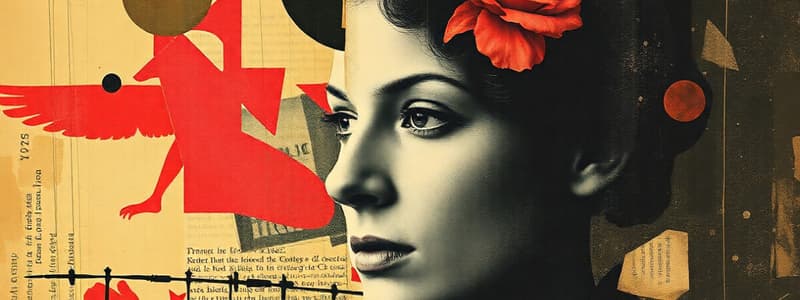Podcast
Questions and Answers
Cal das seguintes opcións describe mellor a función principal da análise do 'fondo' nun comentario de texto literario?
Cal das seguintes opcións describe mellor a función principal da análise do 'fondo' nun comentario de texto literario?
- Identificar e interpretar o argumento e os temas centrais e secundarios da obra. (correct)
- Avaliar a estrutura externa do texto, incluíndo o número de versos e o tipo de estrofa.
- Analizar as figuras fónicas e a métrica empregadas no texto.
- Examinar as características visuais do texto, como a tipografía e a disposición espacial.
Se un poema presenta unha estrutura que comeza cunha introdución, segue cun desenvolvemento dos seus temas e remata cunha conclusión clara, como se cualificaría esta estruturación do tema?
Se un poema presenta unha estrutura que comeza cunha introdución, segue cun desenvolvemento dos seus temas e remata cunha conclusión clara, como se cualificaría esta estruturación do tema?
- Pechada
- Paralelística
- Clásica (correct)
- Aberta
Que aspecto da análise dun texto literario se centra na observación do uso de maiúsculas, minúsculas e alteracións na puntuación?
Que aspecto da análise dun texto literario se centra na observación do uso de maiúsculas, minúsculas e alteracións na puntuación?
- Métrica
- Nivel fónico
- Tema central
- Nivel gráfico (correct)
Cal das seguintes figuras fónicas se caracteriza pola repetición de sons similares en palabras próximas?
Cal das seguintes figuras fónicas se caracteriza pola repetición de sons similares en palabras próximas?
Un verso de 13 sílabas, como se denomina segundo a métrica tradicional?
Un verso de 13 sílabas, como se denomina segundo a métrica tradicional?
Que efecto estilístico adoita producir o uso de versos curtos nun texto poético?
Que efecto estilístico adoita producir o uso de versos curtos nun texto poético?
Como se denomina unha estrofa de catro versos con rima ABBA?
Como se denomina unha estrofa de catro versos con rima ABBA?
Que tipo de composición poética está formada normalmente por catorce versos hendecasílabos distribuídos en dous cuartetos e dous tercetos?
Que tipo de composición poética está formada normalmente por catorce versos hendecasílabos distribuídos en dous cuartetos e dous tercetos?
Cal das seguintes figuras retóricas morfosintácticas implica a repetición dunha ou varias palabras ao comezo de diferentes frases ou versos?
Cal das seguintes figuras retóricas morfosintácticas implica a repetición dunha ou varias palabras ao comezo de diferentes frases ou versos?
Que tipo de adxectivo engade unha calidade inherente e obvia ao substantivo, como en 'branca neve'?
Que tipo de adxectivo engade unha calidade inherente e obvia ao substantivo, como en 'branca neve'?
Nun texto, que efecto estilístico adoitan producir os adxectivos, especialmente os explicativos ou epítetos?
Nun texto, que efecto estilístico adoitan producir os adxectivos, especialmente os explicativos ou epítetos?
Cal das seguintes opcións describe mellor a función dos verbos nun texto?
Cal das seguintes opcións describe mellor a función dos verbos nun texto?
Que figura retórica consiste en omitir deliberadamente elementos que se sobreentenden nunha frase?
Que figura retórica consiste en omitir deliberadamente elementos que se sobreentenden nunha frase?
Cal das seguintes figuras retóricas consiste nunha atenuación do que se quere dicir, expresando algo mediante a negación do seu contrario?
Cal das seguintes figuras retóricas consiste nunha atenuación do que se quere dicir, expresando algo mediante a negación do seu contrario?
Que tipo de descrición de personaxes se centra nos trazos morais e psicolóxicos, en lugar da aparencia física?
Que tipo de descrición de personaxes se centra nos trazos morais e psicolóxicos, en lugar da aparencia física?
Cal destes exemplos representa un caso de hipérbole?
Cal destes exemplos representa un caso de hipérbole?
No plano léxico-semántico, que termo se utiliza para describir unha palabra ou expresión antiga que xa non se usa habitualmente?
No plano léxico-semántico, que termo se utiliza para describir unha palabra ou expresión antiga que xa non se usa habitualmente?
Nunha análise literaria, como se denomina a alteración da orde cronolóxica dos acontecementos, presentando saltos ao pasado ou anticipacións do futuro?
Nunha análise literaria, como se denomina a alteración da orde cronolóxica dos acontecementos, presentando saltos ao pasado ou anticipacións do futuro?
Que figura retórica consiste en atribuír calidades ou accións propias dos seres humanos a animais ou obxectos inanimados?
Que figura retórica consiste en atribuír calidades ou accións propias dos seres humanos a animais ou obxectos inanimados?
Que figura retórica combina diferentes sensacións dos sentidos nunha soa expresión?
Que figura retórica combina diferentes sensacións dos sentidos nunha soa expresión?
Cal das seguintes opcións representa un exemplo de tópico literario que exalta a vida sinxela e retirada do campo?
Cal das seguintes opcións representa un exemplo de tópico literario que exalta a vida sinxela e retirada do campo?
Que tipo de xénero literario se caracteriza pola representación de obras concibidas para ser representadas nun escenario?
Que tipo de xénero literario se caracteriza pola representación de obras concibidas para ser representadas nun escenario?
Dentro dos movementos literarios galegos, a que etapa pertencen as Irmandades da Fala?
Dentro dos movementos literarios galegos, a que etapa pertencen as Irmandades da Fala?
Como se chama o xénero literario que emprega a forma de relato curto para transmitir unha ensinanza moral ou práctica?
Como se chama o xénero literario que emprega a forma de relato curto para transmitir unha ensinanza moral ou práctica?
Flashcards
Argumento
Argumento
Resumo conciso dos eventos principais no texto.
Tema central
Tema central
Idea principal que o autor quere transmitir.
Estrutura clásica
Estrutura clásica
División do texto en introdución, desenvolvemento e desenlace.
Aliteración
Aliteración
Signup and view all the flashcards
Onomatopea
Onomatopea
Signup and view all the flashcards
Paronomasia
Paronomasia
Signup and view all the flashcards
Versos simples
Versos simples
Signup and view all the flashcards
Versos compostos
Versos compostos
Signup and view all the flashcards
Verbos
Verbos
Signup and view all the flashcards
Substantivos
Substantivos
Signup and view all the flashcards
Adxectivos
Adxectivos
Signup and view all the flashcards
Adxectivo Especificativo
Adxectivo Especificativo
Signup and view all the flashcards
Adxectivo Explicativo (Epíteto)
Adxectivo Explicativo (Epíteto)
Signup and view all the flashcards
Anáfora
Anáfora
Signup and view all the flashcards
Hipérbato
Hipérbato
Signup and view all the flashcards
Elipse
Elipse
Signup and view all the flashcards
Paradoxo
Paradoxo
Signup and view all the flashcards
Sinestesia
Sinestesia
Signup and view all the flashcards
Diáfora/Diloxía
Diáfora/Diloxía
Signup and view all the flashcards
Lítote
Lítote
Signup and view all the flashcards
Prosopografía
Prosopografía
Signup and view all the flashcards
Etopeia
Etopeia
Signup and view all the flashcards
Anacrónico
Anacrónico
Signup and view all the flashcards
Locus Amoenus
Locus Amoenus
Signup and view all the flashcards
Study Notes
- This document is a guide for literary text commentary.
Analysis of Background or Content
- This involves identifying the argument and theme.
- The theme includes the central (most prominent) theme and any secondary themes.
Analysis of Form or Expression
- This analysis focuses on the structure of the theme, considering whether it follows a classic pattern (introduction, development, resolution) or an open/closed/parallel structure.
Graphic Level
- Considers the arrangement of space (prose, verse, figurative form like calligrams) and typography such as italics or bold.
- It includes orthography (use of upper or lower case, spelling errors, punctuation changes, and inclusion of certain signs like hyphens, parentheses, underlines).
- It also includes calligraphy, the use of manual handwriting, and the use of images, drawings, or xerographs.
Phonic Level
- Figures of sound include alliteration, onomatopoeia, paronomasia, and phonosymbolism.
Metrics
- This refers to the number of syllables.
- Verse types include simple verses (up to 11 syllables) and compound verses (from 12 syllables onward), which involve caesura (hemistiquios).
- "Art" refers to the number of syllables in a verse.
- "Minor art" includes bisyllabic (2), trisyllabic (3), tetrasyllabic (4), pentasyllabic (5), hexasyllabic (6), heptasyllabic (7), octosyllabic (8) verses.
- "Major art" includes enneasílabo (9), decasílabo (10), hendecasílabo (11), dodecasílabo (12), tridecasílabo (13), and alexandrino (14) verses.
- Verse length affects rhythm; short = quick rhythm (common in popular literature), long = slower rhythm.
- The type of rhyme refers to assonance or consonance.
- Number of verses per stanza includes couplet, tercet, and quatrain.
- Types of quatrains include: Cuarteto (ABBA), serventesio (ABAB), redondilla (abba), cuarteta (abab)
- Other verse types include: Quinteto, quintilla, lira (aBabB), Oitava real (ABABABCC, Décima (abbaaccddc), etc.
- Types of composition include romance (octosyllables with assonance in pairs).
- Sonnet: Typically two quartets and two hendecasyllable tercets.
- Silva: A combination of 7 and 11 syllable verses with consonant rhyme, etc.
Morphosyntactic Level
- This refers to the type or category of words that are most abundant.
- Substantives (nouns) indicate the concrete.
- Adjectives provoke slowness and are common in descriptions.
- Types of adjectives include: specificative (casa branca, tellado verde) and explicative or epithets (branca neve, verde herba).
- The placement of adjectives can impact meaning; those placed before emphasize subjectivity.
- Verbs indicate quickness and movement in narratives.
- Figures of speech at the morphosyntactic level include anaphora, parallelism, hyperbaton, chiasmus, asyndeton, polysyndeton, enumeration, epithet, pleonasm, ellipsis, apostrophe, and rhetorical questions.
- Example of Anaphora: Merquei lavanda; merquei caraveis; merquei rosiñas.
- Example of Paralelismo: As mulleres cantaban; os homes bailaban; os nenos xogaban...
- Example of Hipérbato: Chocolate comía Brais.
- Example of Quiasmo: Trouxo mazás verdes e verdes limóns.
- Example of Asíndeto: Dorme, come, xoga.
- Example of Polisíndeto: Dorme e come e xoga.
- Example of Enumeración: Mercou laranxas, tomates, cebolas e leitugas.
- Example of Epíteto: Sombra escura; branca neve.
- Example of Pleonasmo: Saín para fóra; subín arriba.
- Example of Elipse: En abril, (caen) augas mil.
- Example of Apóstrofe: Xurxo, pecha a porta.
- Example of Pregunta retórica: Quen me responde?
Lexical-semantic Level
- Vocabulary is analyzed from various viewpoints, including diachronic or historical (time) considering archaism and neologism.
- Vocabulary is also analyzed from a diatopic, dialectal, or geographic (place) perspective, considering dialectalisms and foreign words.
- Analysis of vocabulary is also conducted from a social and register (or modality) perspective.
Figures of Speech at the Lexical-semantic Level
- Metaphor: Os remos do teu corpo (Your body's oars).
- Similes: Os teus brazos son coma remos (Your arms are like oars).
- Metonymy: involves substituting the container for the content, the hypernym for the hyponym, the brand for the product or the material for the object.
- Hyperbole: Viviu un inferno.
- Personification: As paredes oen.
- Animalization: O porco (alcalde) de pé..
- Oxymoron: includes O silencio sonoro along with os choros secos
- Paradox: includes Nais que non teñen fillos.
- Synesthesia: Primavera amarga; pel sonora; canción fría.
- Diaphora or dilogy: Agora calou a chaqueta.
- Litotes: Non é moi simpático.
Pragmatic Level
- The position of the narrator is considered, whether first, second, or third person alongside whether the receiver is absent, present, collective or individual.
- Consideration should be given to the description of characters (prosopography for physical description or etopea for ethical description).
- Elements of time, such as whether it is linear, continuous, or anachronistic, and speed are important.
- Analysis and thought should be put towards the description of space; symbolic, real, or fantastic.
Localization
- Genre refers to the subject or category which the text belongs to, for example whether it's an epic, lyrical, narrative, dramatic, or didactic piece.
- Consideration of literary topics such as Locus amoenus, Beatus ille, Carpe diem, Ubi sunt?, and Descriptio puellae.
- Époque: Period (movement, literary and century or time in which it develops):
- Examples include the Galician or Castilian literature during the Middle Ages and Renaissance.
Additional Considerations
- Author
- Work
- Opinion
Studying That Suits You
Use AI to generate personalized quizzes and flashcards to suit your learning preferences.




